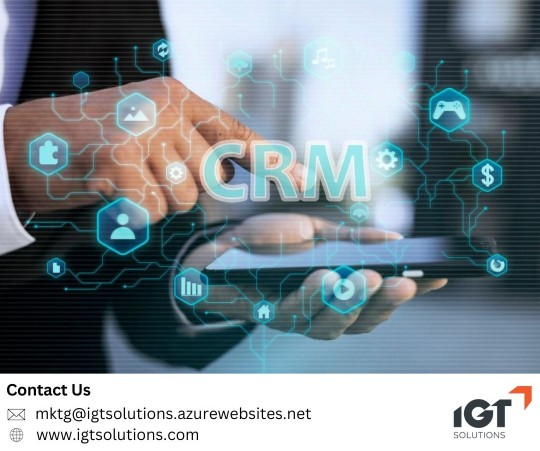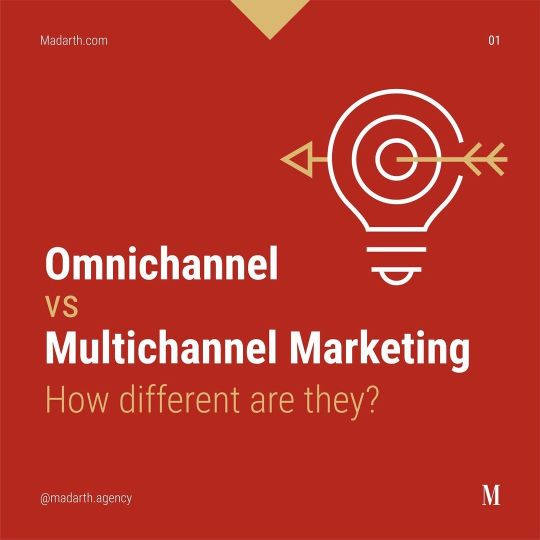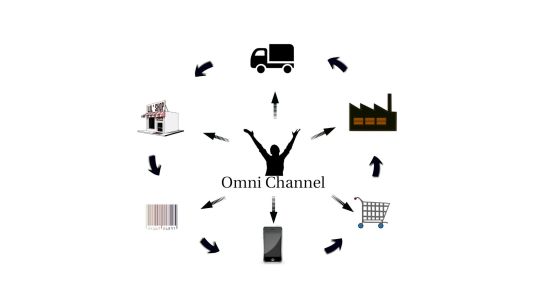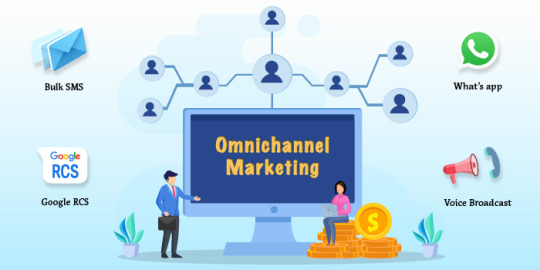#omni channel
Text

Explore the future of customer engagement with our Omni-Channel CRM Solutions 🌐. Craft connected and personalized experiences across every touchpoint 🤝, elevating customer satisfaction and loyalty ❤️. Unleash the potential of seamless communication and interaction 🚀, setting a new standard for your business's customer relationship management.
0 notes
Text
Marketing is significant for selling any product. A marketing channel is a platform or location where the marketing happens. Omni-channel marketing integrates and cooperates with the various channel organizations that interact directly with the customers. This is made to achieve the goal of creating a consistent brand experience. This includes the physical and digital channels. The physical channel is a store, and the digital channel is a website. The Omni Channel Marketing is to creating a convenient and seamless user experience for the customers which is their main goal.
0 notes
Text
Harmonized retail components for holistic omnichannel transformation and hyper local proximity delivery. Anything Retail with a customization factor of 20% required as no one size fits all. Unlock your Effortless Digital first strategy through our Cloud based E-commerce Solutions.
#omnichannel software#omni channel#Retail software SAAS#Retail pos software#Omnichannel Retail#Cloud based E-commerce Solution
1 note
·
View note
Photo

Growth Driven Digital Marketing Agencies in Chennai - Madarth
While multi-channel campaigns cascade a singular message across channels, omni-channel campaigns have a channel-specific strategy. To accomplish this, Digital Marketing Agencies in Chennai use a variety of tactics.
Visit our website: https://www.madarth.com/work/
#madarth#digital marketing agencies#best advertising agencies#performance marketing firm#leading digital agencies#omni channel#multi channel campaigns#omnichannel strategy service#ads campaign strategy service#social media marketing#advertising agencies in chennai#360 degree marketing agencies#inbound marketing agency
0 notes
Text
Percorso cliente omnicanale
Un percorso del cliente omnicanale si riferisce al viaggio di un cliente o potenziale cliente che si sposta attraverso più punti di contatto, attraverso tutte le fasi del ciclo di vita. Un cliente può benissimo iniziare un’interazione su un canale e riprenderla successivamente su un altro canale.
Customer journey omnicanale si riferisce alla strategia di marketing adottata per combinare diversi…

View On WordPress
0 notes
Text

An omnichannel customer interaction strategy with a high level of strength retains 89 per cent of its customers on average, compared to only 33 per cent for organisations with a bad approach.
Read More
#omni channel#omnichannel marketing#omnichannel solutions#bulk sms#bulksms platform#api integration#telecommunication services#telecommunication#business#audio sdk#video sdk#chat sdk#voip call recording
0 notes
Text
Đa kênh đã trở thành xu hướng tất yếu của ngành bán lẻ
Người tiêu dùng đang ngày càng sử dụng nhiều kênh để mua sắm hơn. Do đó, phát triển đa kênh giúp doanh nghiệp tăng trưởng mạnh hơn một nhà bán lẻ có 2 kênh bán hàng thì doanh thu sẽ có cơ hội tăng gần gấp 2 lần.
– Trang Quỳnh
Sự bùng nổ phương tiện kỹ thuật số, thói quen tiêu dùng mới dẫn tới những xu hướng bán hàng đa kênh (Omni Channel) của doanh nghiệp tại Việt Nam. Bán hàng đa kênh được nhận định sẽ trở thành động lực chính đối với công ty bán lẻ trong trạng thái bình thường mới.
Từng là thương hiệu vali, túi xách có doanh thu cao tại thị trường TP.HCM, nhưng từ ngày dịch Covid-19 bùng phát, MIA.vn…

View On WordPress
0 notes
Text
There are VIDEOS out how watcher killed their channel. Oh they are cooked when those videos gonna come out.
7 notes
·
View notes
Text
Omni Channel Analytics: A Comprehensive Guide For Effective Customer Insight


In today’s competitive business landscape, gathering insights about customers and their interactions across multiple channels is essential for success. Omni channel analytics is a powerful way to harness customer data, enabling organizations to make informed decisions, personalize experiences, and optimize business processes. In this article, we will explore the concept of omni channel analytics, its benefits, and some implementation strategies.
Understanding Omni Channel Analytics:
Omni channel analytics refers to the process of analyzing customer data across multiple communication channels. These channels may include websites, mobile apps, social media platforms, call centers, physical stores, and more. By analyzing data from various touchpoints, organizations can gain a holistic view of their customers’ journey, enabling them to understand their behavior, preferences, and needs.
Benefits of Omni Channel Analytics:
Implementing omni channel analytics offers several benefits for organizations:
1. Enhanced customer experience:
By combining data from different channels, organizations can provide a seamless and personalized customer experience. For example, if a customer interacts with a company’s website, call center, and mobile app, omni channel analytics can help create a consistent experience across these touchpoints, making it easier for customers to engage with the brand.
2. Improved marketing effectiveness:
Omni channel analytics allows organizations to identify patterns and trends in customer behavior. This insight can be used to segment customers into groups based on their preferences and needs. By understanding the preferences of different customer segments, organizations can tailor their marketing campaigns accordingly, resulting in higher conversion rates and improved marketing ROI (Return on Investment).
3. Efficient resource allocation:
By analyzing customer data across channels, organizations can identify the most effective channels for customer engagement and allocate their resources accordingly. For example, if a company finds that a majority of its customers prefer mobile app interactions over call center interactions, it can invest more resources in developing and optimizing its mobile app.
4. Better decision-making:
Omni channel analytics provides organizations with actionable insights that can inform their decision-making process. By understanding customer behavior and preferences, organizations can make informed decisions related to product development, service enhancements, pricing strategies, inventory management, and more.
Implementation Strategies for Omni Channel Analytics:
Implementing omni channel analytics involves collecting, integrating, and analyzing data from various channels. Here are some strategies to consider:
1. Data collection and integration:
To implement omni channel analytics, organizations need to collect data from each channel and integrate it into a centralized data repository. This can be achieved through the use of APIs (Application Programming Interfaces) and data integration solutions. For example, an organization can use APIs provided by social media platforms, cloud-based storage solutions, and third-party analytics tools to collect and integrate data from multiple channels.
2. Data analysis and visualization:
Once the data is collected and integrated, organizations can use various analytics techniques to derive insights. This can include techniques such as data mining, machine learning, and predictive modeling. Depending on the size and complexity of the data, organizations can use tools like Python, R, or specialized analytics platforms to perform the analysis. The insights can then be visualized using tools like Tableau, Power BI, or custom-built dashboards.
3. Cross-channel attribution modeling:
Attribution modeling is an important aspect of omni channel analytics. It involves assigning credit to different touchpoints in a customer’s journey based on their contribution to a desired outcome, such as a purchase or conversion. Cross-channel attribution modeling can help organizations understand which channels and touchpoints are most effective in driving customer engagement and conversions.
4. Real-time analytics:
Real-time analytics is crucial for organizations that want to respond to customer interactions in real-time. By analyzing data in real-time, organizations can identify opportunities for upselling, cross-selling, or addressing customer issues immediately. Real-time analytics can be achieve through the use of streaming analytics platforms like Apache Kafka or Apache Flink.
Code Snippet Example:
Here’s an example of how Python can be used to analyze customer data in an omni channel analytics scenario:
In this code snippet, we load customer data from a CSV file and analyze the number of interactions by channel. The data is then visualize using a bar chart to provide a clear understanding of customer engagement across channels.
Conclusion:
Omni channel analytics is a powerful tool for organizations to gain insights into customer behavior and preferences across multiple channels, including Channel Data. By analyzing data from various touchpoints, organizations can enhance customer experience, improve marketing effectiveness, allocate resources efficiently, and make informed decisions. By implementing the strategies mentioned in this article and leveraging appropriate tools and technologies, organizations can harness the power of omni channel analytics, including Channel Data, to drive business growth and stay ahead of the competition.
0 notes
Text
Omni-Channel Retail: Enhancing Customer-Centric Shopping
A recent study highlights the growth potential of the Omni Channel Solutions industry from 2021 to 2027, driven by the rise of hybrid shopping and the buy-from-home economy. The need for seamless transitions between channels has made omnichannel strategies essential.
The study shows that over half of participants value easy digital channel switching during customer interactions. Consequently, 43 percent of companies plan to invest in relevant technologies. RasDigital Agency, an omni-channel digital marketing agency, collaborates with Retailers, B2B Resellers, and Wholesalers to deliver comprehensive omni-channel marketing services using Adobe-Commerce Cloud.
Customer loyalty now depends on a brand's stance on social issues, sustainability, and diversity. The report indicates Gen Z consumers increasingly base their loyalty on these factors. Contact centres are transforming into profit centres, with 67 percent of companies undergoing or completing this transformation. Ninety-eight percent of companies aim to implement proactive customer engagement, recognizing agents as strategic partners in fostering loyalty.
In conclusion, brands must adapt to meet consumer expectations for flexibility across various shopping channels. RasDigital Agency’s Omni-Channel Platform, Adobe-Commerce Cloud, supports businesses in enhancing customer experience across every channel.
Read out our comprehensive blog for more insights:
0 notes
Text
Bridging the Gap: The Power of Digital Marketing for Online and Offline Businesses




Introduction:
The myth that digital marketing is exclusively for online businesses is far from the truth. In reality, digital marketing offers immense benefits for both online and offline businesses by increasing brand visibility, driving customer engagement, and ultimately boosting revenue. In this blog post, we will debunk the myth surrounding digital marketing's limitations and shed light on its potential to bridge the gap between online and offline businesses.
Leveling the Playing Field:
Digital marketing provides an equal opportunity for both online and offline businesses to compete in the digital marketplace. With the right strategies, offline businesses can leverage digital channels to increase their brand visibility, reach new customers, and drive foot traffic to their physical locations. This level playing field allows offline businesses to tap into the vast potential of digital marketing and expand their customer base.
Increasing Brand Visibility:
Digital marketing enables businesses, regardless of their online or offline presence, to increase their brand visibility. By utilizing various digital channels such as search engines, social media platforms, and online directories, businesses can reach a broader audience and make their brand more discoverable. Online businesses can utilize SEO techniques and content marketing to improve search engine rankings, while offline businesses can leverage local SEO strategies to target customers in their vicinity.
Driving Customer Engagement:
Digital marketing provides businesses with the means to engage and interact with their target audience on a more personal level. Online businesses can leverage social media platforms, email marketing, and content creation to foster relationships, address customer queries, and provide value to their audience. Offline businesses can use these digital channels to promote events, share updates, and encourage customer feedback, ultimately driving engagement and building customer loyalty.
Omni-Channel Marketing
Digital marketing allows businesses to adopt an omni-channel marketing approach, seamlessly integrating online and offline channels to create a cohesive customer experience. Businesses can use digital channels to drive traffic to physical stores, offer online ordering or reservation options, and provide personalized recommendations based on customer preferences. This integration enhances the overall customer journey, ensuring a consistent brand experience across multiple touchpoints.
Targeted Advertising:
Digital marketing enables businesses to target specific audience segments based on demographics, interests, and online behavior. Both online and offline businesses can leverage digital advertising platforms to reach their ideal customers effectively. Online businesses can utilize targeted ads on search engines and social media platforms, while offline businesses can use location-based targeting to reach customers in their vicinity. This targeted approach maximizes the impact of marketing efforts and minimizes wasted ad spend.
Measurable Results:
Digital marketing provides businesses with the advantage of measurable results and analytics. Both online and offline businesses can track key metrics such as website traffic, conversion rates, customer engagement, and return on investment. This data-driven approach allows businesses to evaluate the effectiveness of their marketing campaigns, make informed decisions, and optimize their strategies for better results.
Building an Online Presence:
Even for offline businesses, establishing an online presence through digital marketing is crucial in today's digital age. An online presence allows businesses to showcase their products or services, provide important information, and engage with customers beyond their physical locations. Having a strong online presence not only increases brand visibility but also helps build credibility and trust among potential customers.
Conclusion:
The myth that digital marketing is only for online businesses is debunked by the reality that it offers significant benefits to both online and offline businesses. Digital marketing levels the playing field, increases brand visibility, drives customer engagement, enables omni-channel marketing, facilitates targeted advertising, provides measurable results, and allows businesses to build an online presence. By embracing the power of digital marketing, businesses can bridge the gap between their online and offline operations, expand their reach, and drive growth in today's digital-driven world.
#Digital Marketing#Online Business#Offline Business#Brand Visibility#Customer Engagement#Omni-Channel Marketing#Targeted Advertising#Measurable Results#Online Presence#Data-Driven Decision Making
0 notes
Text
Mastering Marketing Strategies: A Comprehensive Guide to Inbound and Outbound Marketing Techniques
In today's dynamic digital landscape, mastering marketing strategies is essential for businesses to stay ahead of the curve and effectively reach their target audience. Two prominent approaches in marketing, inbound and outbound marketing, offer unique methodologies and tools to engage customers and drive growth. Additionally, leveraging omni-channel marketing software can amplify the impact of these strategies by providing seamless integration across multiple channels. In this article, we'll delve into each of these areas, exploring their concepts, tools, pricing models, and the role they play in modern marketing campaigns.
Understanding Inbound Marketing:
Inbound marketing focuses on attracting potential customers through valuable content and experiences tailored to their needs and interests. This approach aims to create meaningful connections and build trust, ultimately leading to long-term relationships with customers. Key components of inbound marketing include content creation, search engine optimization (SEO), social media marketing, email marketing, and lead generation tactics.
Inbound Marketing Tools and Software:
Inbound Marketing tools and software platforms facilitate the execution of inbound marketing strategies. Content management systems (CMS) like WordPress and HubSpot enable businesses to create and manage engaging content efficiently. SEO tools such as SEMrush and Moz help optimize website visibility and performance on search engines. Social media management platforms like Hootsuite and Buffer streamline the process of scheduling and analyzing social media posts. Email marketing software such as Mailchimp and Constant Contact assist in creating personalized email campaigns and automating workflows. Pricing for these tools varies depending on features, scale, and subscription models, ranging from free versions to enterprise-level plans.
Inbound Marketing Pricing:
Inbound marketing pricing structures typically include subscription-based models, tiered pricing based on features and usage, and custom pricing for enterprise solutions. Basic plans for inbound marketing software may start as low as $10-$50 per month, offering essential features for small businesses and startups. Mid-tier plans with advanced functionality and support services may range from $100-$500 per month. Enterprise-level solutions tailored for large organizations often require custom quotes based on specific requirements and scale.
Exploring Outbound Marketing:
In contrast to inbound marketing, outbound marketing involves proactive outreach to potential customers through traditional advertising channels. This includes strategies such as cold calling, direct mail, television and radio commercials, print advertisements, and outbound email campaigns. While outbound marketing casts a wider net in terms of audience reach, it often relies on interruptive tactics and may encounter resistance from consumers accustomed to ad-blocking measures and personalized content preferences.
Outbound Marketing Software:
Outbound marketing software enables businesses to execute targeted outreach campaigns and track their effectiveness. Customer relationship management (CRM) platforms like Salesforce and Zoho CRM facilitate lead management, contact segmentation, and personalized communication. Email marketing tools such as Sendinblue and SendGrid offer features for creating and sending outbound email campaigns at scale. Additionally, advertising platforms like Google Ads and Facebook Ads provide tools for launching and optimizing paid advertising campaigns across various channels.
Embracing Omni-Channel Marketing:
Omni-channel marketing integrates multiple channels and touchpoints to deliver a cohesive and seamless experience for customers. This approach recognizes that consumers interact with brands across various devices and platforms and aims to provide consistent messaging and service throughout their journey. Omni-channel software centralizes data and insights from different channels, enabling businesses to orchestrate personalized campaigns and measure cross-channel attribution effectively.
Unlock the power of seamless customer experiences with our omni-channel provider services and software solutions. Omni-channel marketing has revolutionized the way
businesses engage with their audience by integrating multiple channels into a cohesive strategy. Our omni-channel software empowers you to deliver personalized messaging and consistent branding across all touchpoints, from web and mobile to social media and physical stores.
As a leading omni-channel provider, we understand the importance of meeting customers where they are and delivering a unified brand experience. Our omni-channel marketing solutions leverage advanced analytics and automation to synchronize interactions, optimize campaigns, and drive conversion rates. Whether you're a small business looking to expand your digital presence or a large enterprise seeking to streamline customer engagement, our omni-channel software offers the flexibility and scalability to meet your needs.
Conclusion:
Inbound and outbound marketing strategies each offer distinct advantages and play complementary roles in a comprehensive marketing strategy. By leveraging the right tools and software solutions, businesses can optimize their marketing efforts, engage with their target audience more effectively, and drive measurable results. Additionally, adopting an omni-channel approach allows organizations to create unified brand experiences and stay ahead in today's competitive landscape. Whether you're focusing on attracting leads through inbound tactics, reaching out to prospects via outbound channels, or integrating both approaches for maximum impact, mastering marketing strategies is key to achieving sustainable growth and success in the digital age.
#Inbound Marketing#Inbound Marketing Tools#inbound marketing pricing#outbound marketing#outbound marketing software#Omni-channel marketing#Omni-channel marketing software
0 notes
Text

Our Martech business solutions can accelerate your customer journeys and generate revenue.
#Omni channel content strategy#Martech solutions company in USA#Martech services in USA#Martech Service Company in USA
0 notes
Text
Beyond Multichannel: Why an Omnichannel Strategy is Essential for Brand Loyalty
Let’s explore the exciting world of multichannel and omnichannel techniques. We’ll look at what an omnichannel strategy is and why implementing one is critical for building steadfast brand loyalty, especially in a competitive industry.
Customers interact with businesses through several touchpoints, including online, in-store, and on phones. Having a strategy that connects interactions across multiple channels is critical. It creates a consistent, cohesive brand experience.
Without this, customers become frustrated when information is inconsistent or they must repeat themselves. This erodes allegiance quickly! The omnichannel approach enables customers to interact with your brand when and where they choose seamlessly.
The benefits are enormous! Omnichannel clients return more frequently and recommend your brand to others. By meeting them where they are, you can build genuine long-term partnerships. This loyalty is marketing gold, keeping the competitors at bay.
So, fellow marketers, let’s shift our mindset from multichannel to omnichannel. This is how you create seamless experiences that set you distinct. When done correctly, it earns consumer loyalty, which boosts sales and growth!

The significance of client involvement and consistent user experience in today’s industry.
It’s critical to meet clients where they are at. Going multichannel involves having a presence on several channels, such as social media, websites, and applications. When you convert to an omnichannel approach, you want to connect all of those channels effortlessly. The goal is to give customers a consistent experience no matter where they encounter your brand. It is the endeavor to create personalized journeys for each unique consumer, designed precisely for them.
According to Accenture’s research, 44% of customers return and purchase after receiving a personalized shopping experience. But why is personalization so important? In a world where we are always attached to our smartphones, brands must prioritize consumer engagement. People want and demand personalized experiences; they want firms to remember their preferences, whether they are perusing a website or conversing on Twitter.
According to Epsilon, 80% of customers are significantly more likely to purchase from a firm that provides a personalized experience. This means that providing clients with a consistent experience entails far more than simply being available across several media. It is about providing a consistent experience every time customers interact with you. This also means no more sudden changes or differing messages across platforms, which could confuse. The transition from a multichannel to an omnichannel approach is altering the game for brands.
Companies are learning that to stand out and earn true loyalty, they must go beyond simply providing various forms of outreach.
Understanding the difference between multichannel and omnichannel strategies.
What Is the Omnichannel Customer Engagement Solution?
Connecting with clients through several channels has always been critical. People want seamless experiences across all digital platforms, including social media, email, and AI chatbots. Building strong relationships across platforms is essential for satisfying customers and standing out as a company.
The main advantage is that it allows you to create individualized interactions based on customer participation. By combining data points from several channels, you receive insights on how to tailor offerings to buyer wants and habits, which is a game changer for relationships and companies. Multichannel marketing is vital for long-term revenue and loyalty growth.
Having integrated solutions across touchpoints is no longer simply good practice; it is vital for success in the digital environment. Customers desire a frictionless experience whenever they interact with your brand. Bringing coherence to such engagements makes people happier while also accelerating your growth. Multichannel is becoming the new standard that all sensible businesses should aspire for. Those who realize their full potential will undoubtedly have an advantage over their competitors!
The Advantages of Using a Multichannel Approach
Having multiple ways to connect with clients can help a firm expand. Here are some reasons why.
Reach More People — By being active on social media, sending emails, and having physical stores, firms may reach a larger number of potential customers. You don’t want to miss out because some people prefer Instagram while others only check their email!
Strengthen Relationships — With various channels, you have more opportunities to communicate with clients and get to know them better. This leads to stronger ties and a community that cares more about your business. Personalized experiences based on their preferences result in satisfied, loyal consumers who provide valuable input to help you enhance your services.
More Sales- Getting people from discovering you to pulling out their checkbook is easier when many channels collaborate. Social media ads may expose consumers to products, emails can remind them to buy, and actual storefronts make it possible! This coordinated technique generates more money overall.
In short, multichannel marketing is extremely beneficial for getting your brand out there, interacting with the appropriate people, and increasing business.
More channels equal more opportunities!
Limitations of the Multichannel Approach.
Limitation 1: Integration challenges.
Coordinating marketing efforts across several platforms, such as social media, email, and websites, may be difficult and time-intensive. To maintain consistency for the consumer across all touchpoints, branding, messaging, and user experience must be seamlessly aligned. This needs to be scalable as the brand grows.
Limitation 2: **Data fragmentation.
With client interactions spread across multiple media, it is difficult to understand consumer behavior. This has a significant impact on the ability to generate individualized and targeted marketing efforts that are relevant to individual tastes and needs.
Limitation 3: Resource-intensiveness
Implementing and maintaining a multichannel strategy requires a significant investment of resources such as time, people, and technology. To properly manage their multichannel presence, businesses require powerful support systems that include everything from content production for many platforms to channel performance monitoring.
The Rise of Omnichannel Strategy.
Definition and Characteristics of an Omnichannel Approach.
What exactly is omnichannel, and how does it vary from traditional channels? The omnichannel marketing strategy is all about giving customers a consistent experience across all touchpoints, whether online, on their phones, or at a physical store.
Omnichannel, as opposed to multi-channel, considers all channels simultaneously. This implies that buyers can interact with your brand in a variety of ways while still feeling connected with ai chatbot api and unified data across the journey are two critical aspects of a strong omnichannel.
In today’s interconnected world, individuals expect businesses to understand their preferences wherever they interact, minimizing time spent searching. Omnichannel not only satisfies but anticipates that expectation by utilizing data and technology to offer relevant, timely messaging at all touchpoints.
Taking this approach allows businesses to increase customer involvement and predict consumer habits using data. A good omnichannel strategy involves reaching customers where they are while maintaining a consistent brand story throughout their journey.
Conclusion
The important takeaway here is that moving from numerous channels to a single unified channel that encompasses all touchpoints is critical for organizations looking to develop strong, long-term relationships with customers. We reviewed the major themes that demonstrate why it is so vital and helpful to embrace an omnichannel approach — it comes down to companies needing to integrate experiences across the board to drive growth in such a competitive landscape.
As we move, brands must identify this as a watershed moment and take strides toward an omnichannel strategy by combining everything into a single seamless consumer journey. If they do not adapt, they will fall behind, and Enablex can be their go-to solution for seamlessly executing this, providing them with the tools and backup they need to elevate their presence and how they engage users.
#chat bot api#ai chat api#chat ai api#api ai chatbot#omni channel chatbot api#conversational chatbot api
0 notes
Text
The Power of Omni Channel Communication Software Solutions
Understanding Omni Channel Communication Software Solutions
Omnichannel customer engagement platforms are sophisticated tools designed to integrate communication channels such as email, SMS, social media, live chat, and more into a single platform. Unlike traditional multi-channel approaches, which operate in silos, omni channel solutions provide a cohesive experience across all touchpoints, enabling businesses to deliver personalized and timely messages to their customers.
Unified Interface: Omni channel communication software solutions offer a centralized dashboard that allows businesses to manage all communication channels from a single interface. This unified approach simplifies workflows and improves efficiency by eliminating the need to switch between multiple platforms.
Personalization: By gathering data from various channels, omnichannel interactions enable businesses to create personalized communication strategies tailored to individual customer preferences and behavior. This personalized approach enhances customer engagement and fosters stronger relationships between businesses and their customers.
Automation: Automation is a key feature of omni channel communication software solutions. Businesses can automate routine tasks such as message scheduling, response handling, and customer segmentation, allowing them to focus on strategic initiatives and providing a seamless experience for customers.
Analytics and Reporting: These solutions provide comprehensive analytics and reporting tools that offer insights into customer behavior, campaign performance, and overall communication effectiveness. By analyzing these metrics, businesses can make data-driven decisions to optimize their communication strategies and improve customer satisfaction.
Scalability: White label omni channel communication are highly scalable, making them suitable for businesses of all sizes. Whether you're a small startup or a large enterprise, these solutions can accommodate your growing communication needs without compromising on performance or quality.
Choose the Right Solution: With a wide range of omni channel communication software solutions available in the market, it's important to choose one that aligns with your business needs and objectives. Consider factors such as features, pricing, scalability, and ease of integration when evaluating different solutions.
Provide Training and Support: Ensure that your team is adequately trained on how to use the omni channel communication software solution effectively. Provide ongoing support and resources to help them navigate the platform and maximize its capabilities.
Omni channel communication software solutions offer businesses a powerful toolset for maximizing engagement and delivering seamless communication experiences across multiple channels. By leveraging these solutions, businesses can personalize their communication strategies, automate routine tasks, and gain valuable insights into customer behavior. With careful planning and implementation, businesses can unlock the full potential of omni channel communication software solutions and drive greater customer satisfaction and loyalty.
#omni channel communication software solutions#omni channel communications services#omnichannel customer engagement platform#white label omni channel communication#omnichannel interactions#omnichannel communications solutions#omnichannel communications platform
0 notes
Text
How Omnichannel Solutions Can Help You Connect with Your Customers

In today’s fast-paced digital landscape, businesses strive to create meaningful connections with their customers. The key to achieving this lies in understanding and implementing omnichannel solutions, which offer a seamless and cohesive customer experience across multiple touchpoints. This blog explores the essence of omnichannel customer service, its benefits, and how it stands apart from multichannel approaches, ultimately highlighting Global Plugin as a powerful choice for omnichannel services.
In an era where customer expectations are at an all-time high, businesses are constantly searching for strategies to not only meet but exceed these expectations. Omnichannel solutions have emerged as a beacon of hope in this regard, offering a way to engage customers across various platforms without losing the context or quality of the interaction. This cohesive approach is fundamental in today’s Omni Channel Commerce Solutions.
What is Omnichannel Customer Service?
Omnichannel customer service integrates multiple communication channels to offer a unified customer experience. Unlike traditional methods that operate in silos, omnichannel allows businesses to connect with customers whether they’re on social media, email, phone, or in-person, providing a seamless transition and consistent service across all platforms.
Benefits of a Successful Omnichannel Customer Experience
A well-implemented omnichannel strategy brings numerous benefits:
Enhanced Customer Satisfaction: By offering consistent and personalized interactions across all channels, businesses can significantly improve customer satisfaction levels.
Increased Customer Loyalty: Seamless experiences contribute to a positive brand perception, encouraging customers to return.
Higher Revenue: A satisfied and loyal customer base is more likely to make repeat purchases and recommend the brand to others, directly impacting revenue.
Efficient Problem Solving: Omnichannel solutions provide customer service representatives with a holistic view of the customer’s history, enabling them to resolve issues more efficiently.
Exploring the Multichannel vs. Omnichannel Distinction
While both strategies involve interacting with customers across multiple channels, the key difference lies in integration. Multichannel approaches treat each channel as a separate entity, potentially leading to disjointed customer experiences. In contrast, omnichannel ensures that all channels are interlinked, offering a cohesive experience no matter the platform.
Impact of Omnichannel on Customer Interactions
Omnichannel solutions transform customer interactions by ensuring consistency and personalization. Customers enjoy a tailored experience that recognizes their history with the brand, regardless of the channel. This approach not only boosts engagement but also fosters a deeper connection between customers and the brand, making every interaction more meaningful.
Global Plugin: A Powerful Choice for Omnichannel Services
Choosing the right platform for omnichannel services is crucial, and Global Plugin stands out as a powerful solution. It excels in integrating various communication channels, offering businesses a comprehensive tool to manage their omnichannel strategies effectively. With its advanced features and ease of use, Global Plugin enables businesses to implement a robust Omni Channel Commerce Solutions strategy, ensuring they are always connected with their customers in the most efficient way possible.
In conclusion, the shift towards omnichannel solutions is not just a trend but a necessary evolution in customer service. It reflects a deep understanding of modern consumer behavior and a commitment to meeting their expectations at every touchpoint. By adopting omnichannel strategies, businesses can ensure they’re not just reaching their customers but connecting with them on a meaningful level. Global Plugin emerges as a key player in this domain, offering the tools and capabilities businesses need to thrive in the omnichannel landscape.
0 notes